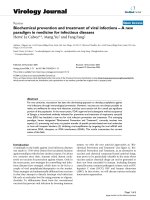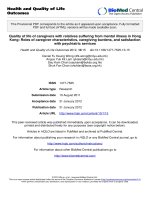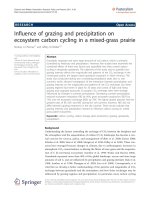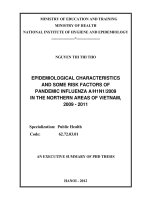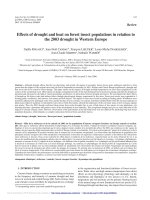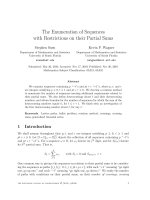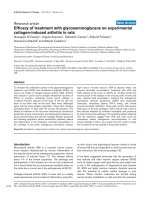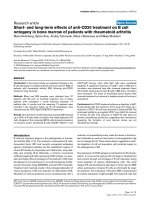A CATALOGUE OF THE FISHES OF BERMUDA, WITH NOTES ON A COLLECTION MADE IN 1905 FOR THE FIELD MUSEUM, ELLIOT 1906
Bạn đang xem bản rút gọn của tài liệu. Xem và tải ngay bản đầy đủ của tài liệu tại đây (4.36 MB, 71 trang )
FIELD COLUMBIAN MUSEUM.
PUBLICATION 108.
ZOOLOGICAL SERIES.
VOL. VII, No.
2.
A CATALOGUE OF THE FISHES OF BERMUDA, WITH NOTES ON A COLLECTION
MADE IN 1905 FOR THE FIELD MUSEUM.
BY
DR. TARLETON H. BEAN,
New
State Fish Culturist of
D. G. ELLIOT, F. R.
S.
Curator of Department.
CHICAGO, U.
S.
July, 1906.
A.
York.
E.
A
CATALOGUE OF THE FISHES OF BERMUDA, WITH NOTES
ON A COLLECTION MADE IN 1905 FOR
THE FIELD MUSEUM.
BY DR. TARLETON
STATE FISH
H.
BEAN
CULTURIST OF NEW YORK.
INTRODUCTION.
The Bermuda
Islands, over three
hundred
in
number, with their
outlying reefs are nearly included between the parallels of 32 10'
and 32 20' N., and between the meridians of 64 40' and 65 W.
The group is about 600 miles east of Cape Hatfrom Greenwich.
and about 1,000 miles from the nearest island of the West
"The line of the outer reef incloses an approximately
elliptical area, whose major and minor axes are respectively about
The major axis
twenty -five and about twelve miles in length.
trends about N. 50 E.
Only a very small part of the elliptical
area thus described is dry land. The dry land is almost confined
to the south-easterly side of the ellipse, forming a narrow and
broken strip about fifteen miles in length, and nowhere more than
The areas of the principal islands are as
three miles in width.
teras,
Indies.
follows:
ACRES
"The Main
Island
9*725
St.
George's Island
Somerset Island
706
David's Island
527
702
Ireland Island
133
"The whole area
12,378 acres.
"The surface
.
of dry land in the archipelago
.
of
.
the land
.....
is
estimated at
...
though
nowhere attaining any great elevation. The highest hills are only
about 250 feet above the level of the sea.
"In consequence of the small extent of the land both horizontally and vertically, and the extreme porosity. of the rock of which
it is composed, there are no springs, streams, or lakes of fresh water
is
considerably diversified,
FIELD COLUMBIAN
22
MUSEUM
ZOOLOGY, VOL. VII.
The rain that falls, where it is not collected in
soaks
down into the porous rock until it mingles
tanks,
near the level of the sea with the salt water with which the lower
The water in the ponds and
parts of the rocks are saturated.
in
the islands.
artificial
.......
marshes, which occupy considerable areas in the
' '
The
less
elevated parts
always brackish.
chain of islands is bordered on the south-east
of the islands,
is
by a fringing
of
a
on
a
mile
the
distant
reef,
average from the
perhaps
quarter
shore.
On the north side of the ellipse the line of the reef is nearly
continuous; but the only dry land is the little islet, or group of
islets, the largest of which, called North Rock, is about eight feet in
diameter and about fourteen feet in height.
.
"The depth of water in the elliptical lagoon inclosed by the outer
'.
reef
is
generally six or eight fathoms, though there are
many
patches
of reef scattered through the lagoon.
Outside of the reef the water
for
a
mile
or
the
more,
deepens gradually
average depth at the distance of a mile being only about twelve fathoms.
little further
A
from the shore a more abrupt descent commences, the depth at a
distance of ten miles in every direction except the southwest being
from 1,500 to 2,250 fathoms. 'Twenty miles to the southwestby-west from the Bermudas there are two submerged banks, twenty to forty-seven fathoms under water, showing that the Bermudas
are not completely alone, and demonstrating that they cover
a summit in a range of heights.' The Challenger expedition obtained
a sounding of 2,950 fathoms about 300 miles further on in the same
direction, indicating apparently that the range
in that direction."-- Prof. William North Rice.
The Bermuda
islands offer
is
not of great extent
numerous bays and other indentaand gravel upon which
tions containing sloping beaches of sand
In only a few
aquatic- animals may readily be taken by seines.
places visited by the writer did low corals interfere with the use of
such apparatus of capture. During the course of an expedition
from August 18 until November 10, 1905, almost all accessgrounds along the shores and on the outlying soundings
were examined with great care and the commercial fishermen aided
by bringing in species which they believed to be desirable for the
lasting
ible fishing
collection.
The
ermen
collecting outfit included all of the apparatus used
seines,
dipnets,
fish
dredges, trawls and tangles for
by fishhand lines, spears
besides
work from a steamer on the Chal-
pots,
lenger and Argus banks.
A number of new or rare species
were
obtained by resounding
CATALOGUE OF BERMUDA FISHES
JULY, 1906.
BEAN.
23
ledges of rock or isolated pinnacles under which fishes hide, and
especially at low water, with a small, fine-meshed bag seine and
then poking under the rocks to frighten the fish into the bag of
the net.
A
bag
%
to
The
secured.
^
and 10 feet deep, 2, i and
inch mesh, with
inch
took
one-half
of
all -the species
mesh,
34
fully
fish pots were found valuable and some fine-meshed
haul seine
of
7
wire eel pots of American manufacture were especially useful for
small species.
The dredges and trawls, made in -St. George's, for use on the
"banks" would have added far more to the value of the collections,
but for the unfavorable weather encountered during the trip. Both
Challenger and Argus banks are rich in animal life and suitable for
extensive dredging and trawling. An account of the trip, written
by Captain Harry Chester, commanding the tug Gladisfen,
herewith
is
given
:
LOG OF THE "CHALLENGER BANK" AND "ARGUS BANK" EXPEDITION IN OCEAN
TUG "GLADISFEN," IN CHARGE OF DR. T. H. BEAN FOR THE FIELD
MUSEUM, ON OCTOBER 12 AND 13, 1905, STARTING
FROM BERMUDA.
October 12, 1905; 9:15 A. M., left St. George's, Berwith
a crew of 12 men and outfit.
muda,
A. M.
Gibbs Hill Lighthouse bearing north, course W. S. W.,
wind S. S. W. fresh wind, and considerable sea and ocean swell.
"
distance 13 miles from Gibbs Hill
Steering for "Challenger Bank,
9: 15 A. M.
n
;
Lighthouse.
12:30 P. M. Sounded with lead line in 58 fathoms; i mile more,
sounded in 30 fathoms, rocky bottom; stopped steamer.
i p. M.
Put a marking buoy with flag overboard in 28 fathoms.
Half mile from our flag buoy sounded in 28 fathoms,
1:15 P. M.
rocky bottom.
P. M.
Sent large dredge, weighted with 300 Ibs. lead, overboard with 60 fathoms of 4-inch Manila rope; fresh breeze
allowed steamer to drift with dredge rope to the bow windlass,
for 15 minutes.
Hove up dredge with steam windlass, it was empty;
1:35 p M
i
:
20
-
-
having evidently fallen on
its
back.
FIELD COLUMBIAN MUSEUM
24
1:55
P.
M.
Put dredge over
2:15
P.
M.
Hove dredge
in
2:50
it,
-ZOOLOGY, VOL. VII.
again.
up, and lowered it again; as it had nothing
of a mile from
shifted steamer's position to the S. E.
%
marking buoy.
P. M.
Sounded 28 fathoms of water; caught from the bottom
sharks, red snappers, rockfish, hamlet and hind with hook and
line.
3:05
P. M.
Hoisted our large dredge up nearly empty again; bottom
even, hard, level, and rocky, bringing up small matter such as
shells and hydro ids, also many nodules.
3:25
P.
M.
We
3:40
P.
M.
Hoisted
used our No. 2 dredge to bottom.
it up with windlass and derrick.
3:50 P. M. Lowered No. 2 dredge again, the steamer backing and
dragging dredge out ahead.
Hoisted dredge from bottom; made a good catch of
4: 20 P.M.
crabs, starfish, brittle stars and nodules.
Wind increased to strong breeze, sea
jumping heavily into a deep ocean
Fish bite readily on small bait
rough and steamer
swell.
of
fish;
bottom even and
rocky.
The
sailors
having
lines
overboard and putting
in
every
when not handling the dredge. Fish plentiful.
No holding ground, and we feel our anchor now let go,
spare minute
4: 25 P. M.
with 80 fathoms hawser, dragging along over a pebble and
nodule bottom.
4:30 P. M. In 28 fathoms of water, sea getting rougher and steamer's deck wet fore and aft.
Anchor would not hold on bottom with 100 fathoms of
hawser out, so that we drifted off soundings.
5:30 P. M. Hove in our cable, and steamed back again for 3 miles,
S. from the N. E. edge of soundings, to windsteering S. W.
ward.
6 P. M.
Wind S. W. stronger, now upon the middle of the "Challenger Bank," anchored again with largest anchor but again
%
dragged this anchor, steamed to the S. W. 2 miles more, where
Fish
the anchor caught in 28 fathoms, rock, smooth bottom.
biting lively and decks are strewn with them, and sharks plentiful.
10 P. M.
Anchor 'holds in 28 fathoms, same bottom; all over this
bank soundings do not vary four fathoms, ranging from 28 to
32 fathoms; rock bottom and teeming with fish.
10 P. M.
It now begins to blow hard, the sea is high, barometer
unsteady, and steamer rolling and jumping; water shipping
JULY, 1906.
CATALOGUE OF BERMUDA FISHES
and aft and not a dry spot on
Anchor is holding.
fore
BEAN.
25
de'ck.
Gale increasing during the night with Manila cable, 100
fathoms, out ahead.
Fish bite and keep coming on deck from hook and line.
Flying fish observed flying in long half circles throughout
the afternoon and evening about the steamer.
12 midnight.
Steamer dragging anchor for half a mile and then
gripped anchor again in some rock upon the level bottom, which
seems to be overgrown with sea flora.
It
blows hard.
Anchor watch, and
all
hands below
for the night.
Oct. i3th, 1905.
Steamer started to drag for a mile .over
bottom and held again.
4 A. M.
smooth pebble rock
Anchor watch busy at the anchor' cable, preventing its
chafing off at the stem of the steamer; as ship is riding and
laboring in a southwest gale, with heavy S. W. sea running
choppy and short, in 28 fathoms of water.
8 A. M.
Wind S. S. W. strong, having somewhat moderated since
We hove up anchor, having had fish pots out
early morning.
all night on the bottom, but no fish in them.
8 A. M.
Started for the "Argus Bank" to S. W. from "Challenger
S.
Bank," steering by compass S. W. by S.
A.
M.
After
for
Patent
miles
9: 15
running
8^
log, sounded in
by
fathoms
on
Bank."
30
"Argus
9:30 A. M. Course S. W., sounded in 30 fathoms with two baited
hooks on leadline, hauled up 2 rockfish at once, also on another
X
9 140
9:
2-hook line 2 sharks at once.
A.M. Thirty fathoms, smooth
hauled in more fish.
50 A. M.
More
fish biting
on hook
level
bottom rocky,
hard;
,
bait; red snappers,
rockfish,
Sea rough and wind blowing fresh. Thirty fathoms water as before and more fish from bottom.
Put dredge No. 2 overboard with heavy leads attached;
9: 50 A. M.
it dragged along bottom but came up empty.
10 A. M.
Sent dredge down again with 90 fathoms Manila line;
ship drifting about 2 miles per hour with the wind and sea.
hamlet, etc.
10:30
A. M.
Brought up pebbles and small nodules,
crabs, hydroids, corals, etc.
found the bottom of the
We
"Argus Bank"
form and rocky as the "Challenger Bank."
shells,
as level
spider
and uni-
FIELD COLUMBIAN MUSEUM
26
ZOOLOGY, VoL.VII.
Put the Manila rope yarn tangle drag overboard with
80 fathoms of line and hauled a great many hydroids and crus-
10: 35 A. M.
taceans.
:
We
hauled in a fine lot of fish of the same kinds as on
Bank" with hook and line.
10 A.M.
Wind now changing to the west and northward;
ugly clouds overcast the horizon and every indication of a northwest gale. We had the Manila rope yarn drag overboard, but
10 35 A. M.
"
Challenger
ii
:
the heavy seas would lift and jerk it off the bottom although
heavily weighed with 5o-lb. leads; we were obliged to heave it
on board, with fair results.
Weather warm and thermometer ranging about 75 to 80
throughout the two days.
n: 45
A. M.
thing,
Heavy
and ship
rain
and dark thick 'weather obscured everyand thumping into a cross sea.
rolling
"
"
A.M. We left
Argus Bank,
steering northeast for east
end Bermuda thick weather.
2: 30 P. M.
Sighted Gibbs Hill Lighthouse, bearing north.
By Ship Log "Argus Bank" to "St. Davids Island Light;"
east end of Bermuda is 38 miles, N. E. course.
Arrived in St. George's Harbor, all well, with a good catch
4 P. M.
on board.
CAPTAIN HARRY CHESTER,
ii 155
;
Tug "Gladisfen."
The expedition obtained 166 species of fishes of which twelve are
believed to be new to science. The new species, with one exception,
were described in the Proceedings of the Biological Society of Wash-
The whole number of recorded species, as
ington, Feb. 26, 1906.
will be seen from the subjoined catalogue, is 261.
Only a single species belongs to the fresh-water series, and that
the introduced goldfish.
A killifish (Fundulus bermudce) is native
to the brackish waters in several of the islands.
The rest of the
is
fishes are
marine and nearly
all
are
members
of the
West Indian
fauna.
Since the return of the expedition Mr. Louis L. Mowbray has
obtained the following species:
Siphostoma jonesi, Rhomboplites
aurorubens, C anthigaster rostratus, and an undetermined Pontinus.
The writer, because of pressure of other work, cannot at present
discuss the characteristics
but desires to submit a
list
and the relations of the Bermuda fishes,
mentioned by recent writers
of the species
JULY, 1906.
and hopes
CATALOGUE OF BERMUDA FISHES
same
to return to the
field
at
BEAN.
27
some future time
to obtain
materials for an adequate presentation of the subject.
Thanks are due to the people in Bermuda who assisted the
Field
Museum
representatives in
many ways
during the progress
Archdeacon Tucker, Capt. W. E.
William Allen, Miss Allen, Mr.
Richard Darrell, and Mr. F. Goodwin Gosling whose generosity
Mr. Louis L. Mowbray was attached to the
will not be forgotten.
and part of November and rendered
October
during
expedition
most excellent service.
The expedition brought back many articles for other Departments
of the Museum, besides numerous invertebrates and reptiles for the
Department of Zoology. The method of collecting the lizard, which
is so abundant on Castle Island, was suggested by a David's Island
native to a member of the crew of our little steam launch and by
of the expedition and especially to
Meyer, .Mr. F. B. Spurling, Mr.
A tall glass jar having a streak
successfully applied.
on the inside, below the neck, was stood on the ground.
Stones were placed so as to give the lizards easy access to the mouth.
They came in large numbers, slipped into the jar and could not
In about two hours thirty-three fine examples were taken
escape.
him very
of butter
in a single jar
The wood
by that
rat,
plan.
now
traps set on the trees
very fond.
rather scarce on the islands, was taken in
and baited with bananas of which they are
It is understood that all the species with which collector and
museum's' catalogue numbers are associated were obtained by the
expedition of 1905. The whole number of recorded species is 261,
of which 1 66 were taken from August to November, 1905, with the
exception of a few that were purchased from Mr. L. Mowbray. In
this list the first number under the name of a species is the museum
catalogue number, the second is the field number of the collector.
The
classification followed
47. U. S.
is
National Museum.
that of Jordan
& Evermann
in Bulletin
CATALOGUE OF THE
I.
1.
RECORDED FROM BERMUDA.
Family Branchiostomidse.
Branch iostoma caribaeum Sundevall.
4902
4903
4904
2.
FISHES
No. 566.
No. 608.
No. 942.
Flatts, in sand.
AMPHIOXUS.
38 spec.
Sept. 27.
28 spec.
Sept. 30.
6 spec.
L. Mowbray.
Flatts, in sand.
Flatts, in sand.
July
Asymmetron lucayanum Andrews.
4858
No. 943.
Near Castle Roads.
L.
Mowbray. 4
spec.
Aug.
16, 1904.
The
largest of these
IX.
3.
is
Family Giiiglymostomidae.
Ginglymostoma cirratum (Gmel.).
GOODE, Am. Jour. Sci. Arts, xiv,
XI.
4.
about one inch long.
Oct., 1877, 293.
Family Galeidre.
Carcharhinus lamia (Raf.). SHARK.
4937 No. 324. South of Castle Id. Hook. Oct. 4.
621
No. 873. Challenger Bk. Hook. Jaws only.
5.
Carcharhinus platyodon (Poey). PUPPY SHARK.
BARBOUR, Bull. M. C. Z., XLVI, No. 7, 1905, in.
6.
Eulamia obscura (Le S.).
GOODE, Am. Jour. Sci. Arts,
7.
xiv, Oct., 1877,
293.
Mustelus canis (Mitch.). NURSE SHARK.
GOODE, Am. Jour. Sci. Arts, xiv, Oct., 1877, 293.
29
Oct. 12.
XII.
8.
Sphyrna zygaena (L.).
GOODE, Am. Jour. Sci.
Arts, xiv, Oct., 1877, 293.
Family
This
is
Sci. Arts, xiv, Oct., 1877, 293, as Isuropsis sp.
probably dekayi,
XXVII.
belongs to this genus.
Family Acipenseridse.
Acipenser sp. STURGEON.
GOODE, Am. Jour. Sci. Arts, xiv,
Carassius auratus(L.).
GOODE, Am. Jour.
Oct., 1877, 293.
Family Cypriiiidse.
GOLDFISH.
Sci. Arts, xiv, Oct., 1877, 293.
XLIII.
13.
it
Family Myliobatidse.
XXXVII.
12.
if
Aetobatus narinari (Euphrasen). WHIP MORAY.
4830 No. 461. The Lane, Hamilton. Oct. 19.
No. 462. The Lane, Hamilton. Oct. 19.
4831
4832 No. 463. The Lane, Hamilton. Oct. 19.
XXXI.
11.
Laimmhr
Isurus sp.
GOODE, Am. Jour.
10
ZOOLOGY, VOL. VII.
Family Sphyrnidse.
XV.
9.
MUSEUM
FIELD COLUMBIAN
30
Family Anguillidse.
EEL.
Anguilla chrysypa Rafinesque.
No. 399. The Lane, Hamilton. Oct. 10.
Oct. 19.
4847 No. 478. The Lane, Hamilton.
4848 No. 479. The Lane, Hamilton. Oct. 19.
4849 No. 480. East Paget Pond. Spear. Oct.
4850 No. 481. East Paget Pond. Spear. Oct.
4846
20.
20.
JULY, 1906.
CATALOGUE OF BERMUDA FISHES
XLVII.
14.
Leptocephalus
31
Leptocephalidw.
sp.
GOODE, Am. Jour.
Sci. Arts,
LI.
15.
Family
BEAN.
xiv,
Oct.,
1877, 293.
Family Myridse.
Myrophis punctatus Lutken.
No. 429. Red Bay. Swamp. Hurt. Sept. 28.
No.
Castle Harbor.
L. Mowbray.
932.
5254
July, 1904.
The snout is % as long as the head; the eye small, one-half as
long as the snout. The angle of the mouth extends behind the eye
a distance equal to the .length .of the snout. The pectoral is about
% as long as the head, which is about of distance from gill-opening.
The dorsal begins a little nearer to the vent than to the
to vent.
The greatest depth of the body is.>^ length of head.
gill-opening.
The body is terete for the most part, and a well-developed caudal
fin is continuous with dorsal and anal.
Two individuals were taken, the larger one nearlv T>. inches long,
5253
^
the smaller
7^
inches.
LII.
Family Ophichthyidie.
16.
Myrichthys acuminatus (Gronow). SAND EEL.
GOODE, Am. Jour. Sci. Arts, xiv, Oct. ,1877, 293, as Ophisurus longus.
17.
Ophichthys triserialis (Kaup). SPOTTED SAND EEL.
GOODE, Am. Jour. Sci. Arts, xiv, Oct., 1877, 2 93This is a Pacific coast species, probably not found in Bermuda.
18.
Sphagebranchus anguiformis (Peters).
BARBOUR, Bull. M. C. Z., XLVI, No. 7, 1905,
LIII.
19.
112.
Family Mnreenidse.
Lycodontis funebris (Ranzani). MORAY; GREEN MORAY.
No. 81. Nonsuch Id. Eel-pot. Sept. 6.
5166 No. 178.
Harrington Sd. Fish-pof*. Sept. 8.
5165
FIELD COLUMBIAN MUSEUM
32
No. 338.
5167
5168
5171
Fish-pot. (Brown.)
5.
No. 339.
No. 358.
Gwelly Hole. Fish-pot. (Brown). Oct. 5.
Near Well Bay, Cooper's Id. Pot
(Brown.)
No. 382.
No. 735.
Flatts.
Oct.
5170
Id.
Gwelly Hole, Cooper's
Oct.
5169
ZOOLOGY, VOL. VII.
5.'
Pot.
Oct.
3.
Jones Bay, Cooper's
Id.
Under
rock.
(Brown.)
Oct. 28.
20.
Lycodontis sancte=helenae (Gijnther).
5172
,
5173
5174
5175
5176
21.
SPECKLED MORAY.
Ten miles off Ireland Id. Fish-pot. Aug.
Nonsuch Id. Eel-pot. Sept. 6.
Off Castle Id. Hook.
Oct. 4.
No. 19.
No. 82.
No. 340.
No. 350.
No. 464.
Castle Harbor, near Nonsuch.
Flatts.
Oct. 20.
Pot.
25.
Oct.
5.
Lycodontis Jordan! Evermann and Marsh.
W.
De Nyse remembers a Bermuda moray in
the Coup Aquarium,
in
or
and
Street,
Broadway
Thirty-fifth
1876
1877, that was yellow,
The
the dorsal edged with black and with white blotches on it.
The example was about
fish was like L. jordani from Porto Rico.
20 inches long, and was found under a rock.
22.
I.
Lycodontis moringa '(Cuv.)
GOODE, Am. Jour. Sci. Arts,
SMALL YELLOW-SPOTTED MORAY.
xiv, Oct., 1877, 293, as
Gymnothorax
punctatus.
BARBOUR,
23.
M.
C. Z., XLVI,
No.
7,
1905,
in.
Lycodontis ocellatus (Ag.).
JORDAN
is
Bull.
& EVERMANN,
Bull. 47, U. S. N. M., 1896, 399.
Hariott in
An example 12 inches long, taken by Captain
now in the New York Aquarium, in spirits.
The
serrations
on the hind margin
Bermuda,
of the anterior canines of the
lower jaw are very well shown in this specimen.
Form slender, the
of
is
one-sixteenth
the
total
inch,
greatest depth,
length and nearly
of the length of head.
The eye is as long as the snout and>6head.
^
%
The length
gape of the mouth is nearly > head, the angle of
behind the eye. Anterior nostrils in a moderately long tube; posterior not tubular, placed between the eyes, the
Five enlarged canines in the front
space between them only
eye.
of each jaw; the sides of the upper jaw with about 7 and of the lower
the
of the
mouth placed
far
%
JULY, 1906.
CATALOGUE OF BERMUDA FISHES
BEAN.
33
The vomer has a raised crest without
8 or 9 smaller teeth.
Distance of gill opening from vent about twice head.
Dorsal beginning slightly in advance of gill opening.
jaw with
evident teeth.
Color in spirits, chocolate-brown; the belly and under surface of
head pale; body profusely covered with whitish spots, none of them
Dorsal fin with about .18 dark blotches surroundeve
more than
ing whitish areas; anal with a smaller number of similar dark
markings associated with light spaces, the dark markings forming
an almost continuous margin.
X
24.
-
Echidna catenata (Bloch)
GOODE, Am. Jour. Sci. Arts, xiv,
.
LVI.
25.
Tarpon atlanticus
GOODE, Am. Jour.
(C.
Oct., 1877, 293.
Family Elopidse.
&
Sci.
V.).
Arts, xiv, Oct.,
1877, 293, as Megalops
thrissoides.
LVI I.
26.
Family Albulidae.
Albula vulpes (Linnaeus). GRUBBER.
4833 No. 148. Well Bay, Cooper's
Sept.
4834
4835
4836
4837
No.
No.
No.
No.
27.
Nonsuch Bay.
515.
Flatts.
677.
Nonsuch Bay.
837.
Ely's Harbor.
5
Seine.
young.
5258
Flatts.
2
spec.
Shelly Bay.
Hunt's
No. 838.
'Sept. 4.
Sept. 26.
Sept. 20.
HERRING.
W.
Bay,
2
Allen.
Seine.
spec.
Aug.
Ely's Harbor.
Sept.
Seine.
Sept.
Port Royal.
Seine.
28.
8.
2
Sept. 21.
5259
Seine.
Family Clupeidse.
Opisthonema oglinum (Le Sueur).
No. 67. Hamilton Harbor.
No. 300.
No. 313.
No. 569.
Seine.
Sept. 27.
Seine. 2 young.
Seine. 2 young.
5255
5256
5257
4 young.
5.
161.
LXI.
Id.
Sept. 26.
9.
spec.
Seine.
MUSEUM
FIELD COLUMBIAN
34
28. Sardinella
5300
5301
5302
5303
No.
No.
No.
No.
29. Sardinella
anchovia
195.
558.
759.
811.
(C.
&
V.).
ZOOLOGY, VOL. VII.
ANCHOVY.
D.
16; A. 18.
Sept. 7.
Ruth's Bay, St. David's. Seine. Oct. 4.
The Reach, St. George's. Seine. 6 young. Oct.
Long Bird Id., south shore. Oct. 24.
Flatts.
humeralis
(C.
Seine.
&
23.
PILCHARD.
V.).
5307
No. 58.
No. 113.
No. 147.
No. 672.
Hungry Bay. 3 young. Dip-net. Aug. 29.
Well Bay, Cooper's Id. 3 spec. Seine. Sept. 6.
10 spec.
Well Bay.
Seine.
Sept. 5
Seine.
Soldier Bay, Old Ferry.
Young. Sept.
5308
No. 749.
Smith's
5304
5305
5306
2 3-
J
5309
No. 854.
Id.,
St. George's.
Seine.
Oct.
Young.
7-
Great Bay,
St.
David's.
Seine.
2
spec.
Sept.
18.
30. Sardinella
5310
No.
322.
Shelly Bay.
Sept
LXII.
31.
PILCHARD.
macrophthalmus (Ranzani).
Seine.
2
spec,
(many
taken).
9.
Family Engraulididre.
Stolephorus choerostomus (Goode). HOGMOUTH FRY; FRY.
No. 60. Hungry Bay.
10 spec.
Aug. 29-30.
5420 No. 152. Well Bay, Cooper's Id. Sept. 5.
18 spec.
Oct. 4.
No. 526. Nonsuch Bay. Seine.
5421
No. 669. Wellman Bay. Seine. 6 spec. Sept. 23.
5422
No. 741. Jones Bay, Cooper's Id. Under rocks. Oct
54:23
5424 No. 827. Red Bay, St. David's Id. Oct. 27.
5419
LXVIII.
32.
Synodus
5425
5426
Family Synodontidse.
foetens (Linnaeus).
No. 363.
No. 458.
Long Bay,
SNAKE
FISH.
Somerset.
Seine.
Sept. 22.
Cove near Hunt's Bay, Port Royal
Sept. 21.
5427
No. 710.
28.
Packward's Bay.
Seine.
Sept. 23.
Id.
Seine
.JULY, 1906.
5428
5429
5430
33.
CATALOGUE OF BERMUDA FISHES
No. 844.
No. 859.
No. 877.
Ely's Harbor.
Hamilton.
No
5432
No.
No.
No.
No.
No.
5434
5435
5436
127.
1 86.
Sept. 20.
Sept. 19.
Fred Ingham.
Nov.
6.
SNAKE FISH.
(Agassiz).
Pitts Bay, Hamilton. Maxwell Allen. Sept. 12.
The Flatts. Seine. 2 spec. Sept. 7.
199.
308.
309.
457.
The
Flatts.
5438
5439
No. 516.
No. 582.
No. 595.
Seine.
Sept.
8.
2 spec.
Spanish Point. Seine.
Sept. 9.
Seine.
Sept. 9.
Shelly Bay.
Cove near Hunt's Bay/ Port Royal Id. Seine.
Sept
5437
21.
Nonsuch Bay.
Flatts.
Seine.
Seine.
2
Port Royal Bay.
Synodus saurus (L.).
GOODE, Am. Jour. Sci.
BARBO.UR, Bull. M.
35.
35
Synodus intermedius
5431
5433
34.
Seine.
Seine.
Shelly Bay.
BEAN.
SNAKE
spec.
Seine.
Oct.
21.
Young. Sept.
FISH.
Arts, xiv, 1877, 293, as
C. Z., XLVI,
4.
Sept. 20.
No.
7,
Synodus
lacerta.
1905, 113.
Trachinocephalus myops (Forster). SNAKE FISH.
No. 455. Cove near Hunt's Bay, Port Royal
5463
Id.
Seine.
Sept. 21.
5464
No. 689.
Long Bay, Cooper's
-XCII.
36.
5028
No.
i.
No. 101.
Paget East.
Paget East.
5029
No.
Stocks Point,
5027
5-83.
XCIV.
37.
Seine.
Sept. 25.
Preciliidre.
Family
Fundulus bermudae Gimther.
Id.
MULLET.
Swamp. 7cT,89,8juv. Aug.
Swamp. Many. Sept. 10.
St.
David's Id.
Many.
20.
Sept. 29.
Family
Tylosurus acus (Lacepede). HOUND.
No. 359. Flatts. In pot. Very large.
5471
No. 86. Well Bay, Cooper's Id. Sept.
5472
5473 'No. 132. Gibbet Id. Seine. Sept. 8.
5474 No. 422. Near Red Bay, St. David's Id.
6.
Seine.
Oct. 23.
38.
ZOOLOGY, VOL. VI L
FIELD COLUMBIAN MUSEUM
36
Tylosurus ardeola (C. & V.). HOUND.
No. 188. Flatts. Seine. 4 spec. D. 13; A.
No. 537. Nonsuch Bay, north side. D.
5476
18.
5475
Sept.
13;
i,
A.
7.
1
i,
Sept. 26.
39.
Long Bird Id.
Nonsuch Bay.
No. 562.
No. 675.
5477
5478
Seine. 2 spec.
Sept. 30.
Seine.
Sept. 26.
Tylosurus raphidoma (Ranzani).
Bull. M. C. Z., XLVI, No.
BARBOUR,
40.
1905, 113.
7,
Athlennes hians (C. & V.). HOUND.
4878 No. 130. Gibbet Id. 7 spec. Seine. Sept. 8.
4879 No. 798. The Reach, St. George's. Seine. Oct. 23
.
XCV.
41.
Hyporhamphus
Family
roberti (C.
Hemirhamphidse.
&
5092
5093
No. 573.
Hunt's Bay, Port Royal.
5094
5095
No. 594.
No. 646.
Hyporhamphus
5096
5097
5098
5099
No.
No.
No.
No.
112.
123.
155.
163.
5101
5102
5103
5051
5052
5053
2 spec,
(one deformed).
Sept. 21.
Port Royal Bay.
Old Ferry,
Seine.
St. George's.
Young.
Sept.
21.
Sept. 23.
unifasciatus (Ranzani).
GAR.
Well Bay, Cooper's Id.
Sept. 6.
spec. Seine.
6
and
Nonsuch
Id.
Well Bay
spec.
Sept. 3.
Seine.
Well Bay. Young.
Sept. 5.
2 spec.
Seine.
One injured.
Nonsuch Bay.
2
4.
Flatts.
No. 812.
No. 852.
Long Bird
No. 311..
No. 361.
No. 924.
Sept. 8.
Seine.
Sept. 22.
Long Bay, Somerset.
No. 193.
No. 603.
Hemirhamphus
Seine.
Id. 2 spec.
Sept.
5100
43.
GAR.
Gibbet
Seine.
42.
V.).
No. 131.
No. 364.
5091
Young. Seine. Sept. 7.
Off north shore, at surface, near White's Flat
Shoal.
Very young. Oct. 6.
Id.,
Ely's Harbor.
brasiliensis
south shore.
Seine.
2
Young.
(Linnaeus).
spec.
Oct. 24.
Sept. 20.
GAR.
Smith's Cove, Hamilton. Seine.
Sept.
Long Bay, Somerset. Seine. Sept. 22.
Hamilton Harbor.
Nov.
9.
9.
CATALOGUE OF BERMUDA FISHES
JULY, 1906.
BEAN.
37
Family ExocwticUe.
XCVII.
FLYING FISH.
Hamilton Harbor. Winter.
44. Exocoetus furcatus Mitchill.
No. 923.
5268
Mr. Goodwin Gos-
ling.
This individual
is
3^
inches long to base of caudal.
There are
shaped like a half-leaf, and each of
two black barbels on the
them nearly
chin,
D. 14; A. 9;
as long as the eye.
scales
about 50;
26
rows before dorsal.
Two young, under Sargassum. Oct. 10.
Flatts.
5269 No. 400.
These young examples have five golden bands on the body and
a golden blotch at caudal base.
45. Exocoetus bahiensis
GQODE, Am. Jour.
Ranz.
46. Exocoetus lineatus C.
GOODE,
FLYING FISH.
&
1877, 292.
V.
Bull. U.- S. N. M., v, 1876, 76.
&
47. Exocoetus rondeletii C.
GOODE, Am.
V.
FLYING FISH.
Jour. Sci. Arts, xiv, Oct., 1877, 293.
48. Exocoetus rufipinnis C.
GOODE, Am. Jour.
49.
..
Sci. Arts, xiv, Oct.,
&
FLYING FISH.
V.
Arts, xiv, Oct., 1877,
Sci.
Exonautes exsiliens (Muller).
GOODE, Am. Jour. Sci. Arts,
/-
293. as Exocoetus
BUTTERFLY FISH;
xiv, Oct., 1877, 292,
FLYING FISH.
as Exocoetus
exiliens.
BARBOUR,
Bull.
M.
C.
50.
C. Z., XLVI,
No.
7,
1905, 114.
Family Aulostomidse.
Aulostomus maculatus Val.
An example
23 inches long, taken by Louis Mowbray, August 25,
One Gun, North Shore, St. George's Id., by hook and line,
is now in the
Bermuda Natural History Society's collection at
Hamilton. The specimen agrees with the description of Aulostomus
1893, at
maculatus in Bull. 47, U.
S.
Nat. Mus.
FIELD COLUMBIAN MUSEUM
38
Family Fistnlariidse.
CI.
51. Fistularia
tabacaria Linnaeus.
No. 1096.
5493
CII.
52.
ZOOLOGY, VOL. VII.
On
Off North Shore, St. George's Id.
Family
hook.
MacrorhamphosicUe.
Macrorhamphosus scolopax (L.).
GOODE, Am. Jour. Sci. Arts, xiv,
Oct., 1877, 291, as Centriscus
scolopax.
CIII.
53.
DUCK
Siphostoma elucens (Poey).
Ruth's Bay.
FISH.
5338
No. 561.
'D. 21,
on 1+5 rings; rings 17+33.
No. 704. Packward's Bay, Old Ferry Road.
on i +5 rings.
5344
D. 25,
54.
Family Syngnathidse.
Siphostoma mackayi Swain
mouth
&
DUCK
Meek.
No. 128.
Off
5346
No. 159.
No. 365.
No. 564.
Nonsuch Bay. Seine.
Long Bay, Somerset.
Long Bird Id. Seine.
5347
5339
D. 31, on
Sept. 23.
FISH.
under seaweed.
5345
of Flatts,
Oct. 4.
9.
Seine.
Sept.
Sept. 4.
Seine. Sept. 22.
cT.
Spent.
9.
D. 30.
Sept. 30.
3 +sK rings; rings 17 +32.
Oct. 3.
cT.
5340 No. 598. Flatts.
Spent.
D. 29, on 2 + 6 rings; rings 17 +36.
No. 674. Wellman Bay, St. George's. Seine. 4 spec. Sept.
5341
23-
D. 30, on 2 +6 rings; rings 18 +35.
One male with eggs in pouch.
5348 No. 714. Cable Bay, Tucker's Town. Seine. 'Oct. 26.
Oct. 23.
?
5342 No. 752. The Reach, St. George's. Seine.
.
D. 28, on 2+6 rings; rings 18+34.
No. 753. The Reach, St. George's.
5343
D. 28, on 2 +6 rings; rings 18+3 7.
Seine.
Oct. 23.
No. 775. Cooper's Id., west side. Oct. 25.
5350 No. 809. Long Bird Id., south shore. Oct.
D. 31, on 2 +6 rings.
5349
5351
No. 913.
The Lane, Hamilton.
Seine.
24.
Nov.
7.
JULY, 1906.
55.
56.
CATALOGUE OF BERMUDA FISHES
Siphostoma dendriticum Barbour.
BARBOUR, Bull. M. C. Z., XLVI, No.
Siphostoma jonesi
GOODE, Am. Jour.
jonesii
BARBOUR,
57.
7,
BEAN.
1905, 115, pi.
-
39
i.
(Gthr.).
Sci.
Arts, xiv, Oct., 1877, 291, as Syngnathus
.
Bull.
M.
C. Z., XLVI,
No.
7,
1905, 115.
Siphostoma pelagicum (Osbeck).
GUNTHER, Shore Fish. Chall., 1880, n.
BARBOUR, Bull. M. C. Z., XLVI, No. 7,
1905, 115.
FIGURE
HIPPOCAMPUS BRUNNEUS Bean.
1.
Hippocampus brunneus Bean. SEA HORSE.
BEAN, Proc. Biol. Soc. Wash., xix, Feb. 26, 1906, 32.
5494 No. 1099. Long Bird Id. L. Mowbray. Aug. 29, 1904.
This is a male with pouch recently emptied.
D. 18, on 3 body and i
caudal rings; rings 11+35. Eye 2% in snout, 6 in head. Greatest
depth of body about ^head. Head as long as the body. Coronet
58.
moderate, with
5 spines; supraocular spines well developed; a smaller
spine between the nostrils a pair of spines at the throat a spine in
front of the lower part of the pectoral base and one at the gill opening;
;
;
a pair at the sides of the nape and a spine on the ridge of the nape;
of the body and tail rings are furnished with blunt spines about
7 or 8 pairs somewhat enlarged, alternating with shorter pairs.
Length
most
;
of dorsal base equal to snout.
Color in spirits, chocolate
behind the head,
its
Longest dorsal ray Y* snout.
a triangular whitish blotch immediately
greatest width Y* snout; a larger blotch resem;
FIELD COLUMBIAN
40
MUSEUM
ZOOLOGY, VOL. VII.
bling an hour-glass on the- body, principally on the sixth and seventh
body rings, extending entirely around eight narrow whitish bands
;
the back, the first at the middle of dorsal base, none of these
reaching below the median line.
across
The description
of color of Hippocampus hudsonins, in Bull. 47,
Nat. Mus., 777, apparently relates to this species, but not to the
H. hudsonius of De Kay.
U.
59.
S.
Hippocampus hudsonius De Kay. SEA HORSE.
c\ D. 19. Sept. 28.
5064 No. 392. Flatts.
No. 715.
5065
60.
Cable Bay.
Seine.
D.
19.
Sept. 26.
Hippocampus punctulatus Guichenot. SEA HORSE.
Coot Pond. L. Mowbray.
D. 18.
No. noo.
5495
Sept.
30,
1904.
61.
Hippocampus
5066
62.
stylifer
No. 691.
Jordan
Flatts.
&
Seine.
Gilbert.
SEA HORSE.
Sept. 25.
Hippocampus hippocampus (L.). SEA HORSE.
GOODE, Am. Jour. Sci. Arts, xiv, Oct., 1877, 291, as Hippocampus
antiquorum.
CVI.
63.
Family Atheriiiiclie.
Atherina harringtonensis Goode. BLUE FRY.
4859 No. 99. The Flatts. Seine. Sept. 8
4860 No. 1 1 8. Nonsuch Id. and Well Bay. Seine. Sept. 3.
No. 138. Hayward's Bay, St. David's Id. Sept. 6.
4861
No.
Well Bay, Cooper's Id. Many. Seine. Sept. 5.
4862
151.
No.
Seine.
Flatts.
4 spec.
4863
Sept 7.
190.
Somerset.
No.
4864
Long Bay,
4spec. Seine. Sept. 22.
370.
No. 459. Near Hunt's Bay, Port Royal Id. 2 spec.
.1865
Seine.
4866
4867
4868
4869
4870
4871
Sept. 21.
Seine.
No. 527.
No. 538.
Nonsuch Bay.
Nonsuch Bay.
No.
No.
No.
No.
Hunt's Bay, Port Royal. Seine. 2 spec.
Soldier Bay, Old Ferry. Seine. 6 spec.
552.
565.
577.
670.
Oct. 4.
4 spec.
Seine. 5 spec. Sept. 26.
Tucker's Town Cove. Seine. 2 spec. Sept. 29.
Long Bird Id. Seine. Sept. 30.
Sept. 21.
Sept. 23.
JULY, 1906.
4874
No. 711.
No. 748.
No. 760.
4875
4876
4877
No. 776.
No. 810.
No. 860.
4872
4873
64.
CATALOGUE OF BERMUDA FISHES
Packward's Bay. Seine. 4
Smith's
65.
The Reach, St. George's. Seine. 6 spec.
Oct. 18.
Castle Harbor. 33 spec.
Long Bird
Id.,
Menidia menidia (L.). BLUE FRY.
Bull. M. C. Z., XLVI, No.
common, D. 4+9; A.
i
7
7,
1905, 116.
5209
5211
5212
68.
1905,
116.
exceed-
Based on
Family Mugilidie.
9.
& V. MULLET.
Hamilton Harbor. 10 young. Aug.
Hungry Bay. Young. Aug. 30.
of these has only
No. 115.
No. 502.
No. 746.
Flatts,
C.
2
28.
anal spines.
Well Bay, Cooper's Id. 2 young. Sept. 6.
Doe's Rock. Tide pool. Young. Oct. 26.
Smith's Id., St. George's. Oct. 17.
Mugil trichodon Poey. MULLET.
5210 No. 172. Hay ward's Bay. Seine. Sept. 6.
Sept. 9.
5215 No. 316, Shelly Bay. Seine.
5205 No. 553. Tucker's Town Cove. Seine. Young.
No. 817. Long Bird Id., south shore. Young.
5213
5214 No. 842. Ely's Harbor. Seine. 2 spec. Sept.
CVIII.
69.
7,
Mugil brasiliensis Agassiz. MULLET.
No. 315. Shelly Bay. Seine. Sept.
One
.24.
4-22.
Menidia notata (Mitch.).
BARBOUR, Bull. M. C. Z., XLVI, No.
specimen in M. C. Z., No. 18246.
Mugil curema
5206 No. 64.
No. 65.
5207
Oct.
Sept. 19.
spec.
5208
67.
Oct. 23.
south shore. 14 spec.
Shelly Bay. Seine.
CVII.
66.
41
Sept. 23.
Oct. 17.
large.
Id., St. George's. 3 spec.
BARBOUR.
ingly
BEAN.
Family
Spin
i
:rn i
Sept. 29.
Oct. 24.
20.
.
Sphyraena barracuda (Walbaum). BARRACUDA.
5414 No. 341. Flatts. Seine. Oct. 4.
5415 No. 353. Cable Bay, Tucker's Town. Seine.
Sept. 25.
FIELD COLUMBIAN
42
70.
MUSEUM
ZOOLOGY, VOL. VII.
Sphyraena borealis De Kay. SENNET.
No. 546. Nonsuch Bay. Seine. Sept.
No. 841. Ely's Harbor. Seine. Scales.
5417
5416
29.
120.
Sept. 20.
9
71.
72.
SENNET.
Nonsuch Bay. Seine.
Sphyraena picudilla Poey.
5418
No. 517.
4.
Sphyraena Sphyraena (L.).
GOODE, Am. Jour. Sci. Arts, xiv, Oct., 1877, 292,
BARBOUR, Bull. M. C. Z., XLVI, No. 7, 1905, 116.
CXV.
73.
Oct.
as S. spet.
Family Holocentridie.
Holocentrus ascensionis (Osbeck). SQUIRREL.
No. ii. Hungry Bay. Aug. 24.
5067
5068
'No.
23.
5069
No.
No.
No.
No.
No.
No.
No.
No.
No.
87.
5070
5071
5072
5080
5073
5074
5075
5076
97.
106.
10 miles off Ireland Id.
Fish-pot.
Aug.
25.
Nonsuch Id. Eel-pot. Sept. 3.
The Flatts. Young. Seine. Sept. 8.
357.
Well Bay, Cooper's Id. Seine. Sept. 3.
Hayward's Bay. 3 young. Seine. Sept. 6.
Smith's Cove, Hamilton. Young. Sept. 9.
Great Shoal, Castle Harbor. Pot. Sept. 29.
378.
Long Bay, Somerset. Young,
650.
Old Ferry, St. George's. Seine. Sept.
Great Bay, St. David's Id. Seine.
143.
318.
781.
Sept.
Seine.
Sept. 22.
23.
6
young.
1 8.
5077
No. 843.
Ely's Harbor. Seine. Young.
5078
No. 914.
Hungry Bay.
Seine.
Nov.
Sept. 20.
7.
meeki Bean.
Wash., xix, Feb. 26, 1906, 31.
5079 No. 144. Hayward's Bay, St. David's Id. Seine. Sept. 6.
A squirrel-fish of the small-scaled group represented by H. ascensionis was seined in Hayward's Bay, St. David's Id.
Only two
young individuals were taken. From H. ascensionis the species can
be at once distinguished by its low dorsal and anal rays, its small eye,
and its equal caudal lobes, as well as by other characters.
D. xi, 14 to 15; A. iv, 10; scales 4-54 to 55-7. The head is %
The maxilla extends
of total length to base of middle caudal rays.
74. Holocentrus
BEAN, Proc.
Biol. Soc.
to the perpendicular through the front of the eye.
The eye
is
%
of
JULY, 1906.
CATALOGUE OF BERMUDA FISHES
FIGURE 2.
BEAN".
43
HOLOCENTRUS MEEKI Bean.
the length of the head.
Preopercle with a strong spine at the angle,
not reaching to the edge of the subopercle. Opercle with two very
small flat spines, not
as l n g as the eye.
Preorbital, preopercle.
X
and opercle denticulated. Scales of the body
minutely denticulated, having about 14 spines on the posterior margin.
f total length to base of middle caudal rays.
Depth of body
interopercle, subopercle,
%
Caudal peduncle very slender, its least depth only y, length of head.
The pectoral is about % as long as the head and extends to the i6th
series of scales.
The ventral is y$ as long as the head, and ends far
from the vent. The anal base is
as long as the head.
The longest
dorsal spine is /z as long as the head the longest soft ray is equal to
the longest spine, and when laid back does not extend to the end of
%
l
;
the last ray. The longest anal ray is scarcely equal to the longest
of the dorsal rays.
The first anal spine is minute, the second spine
is about YT, as long as the eye, the third and longest is little more than
y$ as long as the head, the fourth is slenderer
and shorter than the
third.
Color in spirits: body
line shining silvery; all
tinged with purplish;
fins all pale,
above lateral line pale brown, below lateral
but top of head silvery; caudal peduncle
membrane
of spinous dorsal blackish;
other
except caudal, which shows traces of dusky on the lobes;
iris pale.
Length of the two individuals described, three inches and two
and three-fourths inches respectively to base of middle caudal rays.
75. Holocentrus siccifer
Cope.
--H. puncticulatus BARBOUR; H. tortitgce Jordan
No. 497. Nonsuch Id. Eel-pot. 3 young.
5496
D. xi, 13; A. iv, 9; scales 4-43-8.
& Thompson.
Sept. 18.
